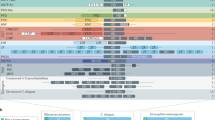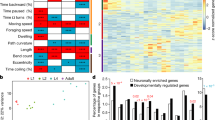Abstract
Dopamine signalling regulates a variety of complex behaviours, and defects in dopamine neuron function or survival result in severe human pathologies, such as Parkinson’s disease1. The common denominator of all dopamine neurons is the expression of dopamine pathway genes, which code for a set of phylogenetically conserved proteins involved in dopamine synthesis and transport. Gene regulatory mechanisms that result in the direct activation of dopamine pathway genes and thereby ultimately determine the identity of dopamine neurons are poorly understood in all systems studied so far2. Here we show that a simple cis-regulatory element, the dopamine (DA) motif, controls the expression of all dopamine pathway genes in all dopaminergic cell types in Caenorhabditis elegans. The DA motif is activated by the ETS transcription factor AST-1. Loss of ast-1 results in the failure of all distinct dopaminergic neuronal subtypes to terminally differentiate. Ectopic expression of ast-1 is sufficient to activate the dopamine pathway in some cellular contexts. Vertebrate dopamine pathway genes also contain phylogenetically conserved DA motifs that can be activated by the mouse ETS transcription factor Etv1 (also known as ER81), and a specific class of dopamine neurons fails to differentiate in mice lacking Etv1. Moreover, ectopic Etv1 expression induces dopaminergic fate marker expression in neuronal primary cultures. Mouse Etv1 can also functionally substitute for ast-1 in C. elegans. Our studies reveal a simple and apparently conserved regulatory logic of dopamine neuron terminal differentiation and may provide new entry points into the diagnosis or therapy of conditions in which dopamine neurons are defective.
This is a preview of subscription content, access via your institution
Access options
Subscribe to this journal
Receive 51 print issues and online access
$199.00 per year
only $3.90 per issue
Buy this article
- Purchase on Springer Link
- Instant access to full article PDF
Prices may be subject to local taxes which are calculated during checkout




Similar content being viewed by others
References
Iversen, S. D. & Iversen, L. L. Dopamine: 50 years in perspective. Trends Neurosci. 30, 188–193 (2007)
Abeliovich, A. & Hammond, R. Midbrain dopamine neuron differentiation: factors and fates. Dev. Biol. 304, 447–454 (2007)
Nass, R. & Blakely, R. D. The Caenorhabditis elegans dopaminergic system: opportunities for insights into dopamine transport and neurodegeneration. Annu. Rev. Pharmacol. Toxicol. 43, 521–544 (2003)
Schmid, C., Schwarz, V. & Hutter, H. AST-1, a novel ETS-box transcription factor, controls axon guidance and pharynx development in C. elegans . Dev. Biol. 293, 403–413 (2006)
Doitsidou, M., Flames, N., Lee, A. C., Boyanov, A. & Hobert, O. Automated screening for mutants affecting dopaminergic-neuron specification in C. elegans . Nature Methods 5, 869–872 (2008)
Voglis, G. & Tavernarakis, N. A synaptic DEG/ENaC ion channel mediates learning in C. elegans by facilitating dopamine signalling. EMBO J. 27, 3288–3299 (2008)
Li, W., Feng, Z., Sternberg, P. W. & Xu, X. Z. A. C. elegans stretch receptor neuron revealed by a mechanosensitive TRP channel homologue. Nature 440, 684–687 (2006)
Allen, Z. J., Waclaw, R. R., Colbert, M. C. & Campbell, K. Molecular identity of olfactory bulb interneurons: transcriptional codes of periglomerular neuron subtypes. J. Mol. Histol. 38, 517–525 (2007)
Saino-Saito, S. et al. ER81 and CaMKIV identify anatomically and phenotypically defined subsets of mouse olfactory bulb interneurons. J. Comp. Neurol. 502, 485–496 (2007)
Arber, S., Ladle, D. R., Lin, J. H., Frank, E. & Jessell, T. M. ETS gene Er81 controls the formation of functional connections between group Ia sensory afferents and motor neurons. Cell 101, 485–498 (2000)
Flames, N. et al. Delineation of multiple subpallial progenitor domains by the combinatorial expression of transcriptional codes. J. Neurosci. 27, 9682–9695 (2007)
Wenick, A. S. & Hobert, O. Genomic cis-regulatory architecture and trans-acting regulators of a single interneuron-specific gene battery in C. elegans . Dev. Cell 6, 757–770 (2004)
Duggan, A., Ma, C. & Chalfie, M. Regulation of touch receptor differentiation by the Caenorhabditis elegans mec-3 and unc-86 genes. Development 125, 4107–4119 (1998)
Etchberger, J. F. et al. The molecular signature and cis-regulatory architecture of a C. elegans gustatory neuron. Genes Dev. 21, 1653–1674 (2007)
Hobert, O. Regulatory logic of neuronal diversity: terminal selector genes and selector motifs. Proc. Natl Acad. Sci. USA 105, 20067–20071 (2008)
Lichtneckert, R. & Reichert, H. Insights into the urbilaterian brain: conserved genetic patterning mechanisms in insect and vertebrate brain development. Heredity 94, 465–477 (2005)
Brown, T. A. & McKnight, S. L. Specificities of protein–protein and protein–DNA interaction of GABP alpha and two newly defined ets-related proteins. Genes Dev. 6, 2502–2512 (1992)
Halder, G., Callaerts, P. & Gehring, W. J. Induction of ectopic eyes by targeted expression of the eyeless gene in Drosophila . Science 267, 1788–1792 (1995)
Weintraub, H. et al. Activation of muscle-specific genes in pigment, nerve, fat, liver, and fibroblast cell lines by forced expression of MyoD. Proc. Natl Acad. Sci. USA 86, 5434–5438 (1989)
Shirasaki, R. & Pfaff, S. L. Transcriptional codes and the control of neuronal identity. Annu. Rev. Neurosci. 25, 251–281 (2002)
Etchberger, J. F. & Hobert, O. Vector-free DNA constructs improve transgene expression in C. elegans . Nature Methods 5, 3 (2008)
Fukushige, T. & Krause, M. The myogenic potency of HLH-1 reveals wide-spread developmental plasticity in early C. elegans embryos. Development 132, 1795–1805 (2005)
Rosen, G. D. & Harry, J. D. Brain volume estimation from serial section measurements: a comparison of methodologies. J. Neurosci. Methods 35, 115–124 (1990)
Gray, P. A. et al. Mouse brain organization revealed through direct genome-scale TF expression analysis. Science 306, 2255–2257 (2004)
Cobos, I., Borello, U. & Rubenstein, J. L. Dlx transcription factors promote migration through repression of axon and dendrite growth. Neuron 54, 873–888 (2007)
Acknowledgements
We thank Q. Chen for injection assistance, M. Doitsidou and J. Chen for providing the ot417 allele, E. Savner for initiating some of the promoter analysis, A. Kruyer for technical help, the CGC for strains, the C. elegans Gene Knockout Consortia, led by S. Mitani at Tokyo Women’s Medical University School of Medicine and by D. Moerman at the University of British Columbia, for knockout alleles, H. Hutter, N. Tavernarakis and T. Jessell for strains and reagents, several members of Columbia University community for sharing their equipment, Hobert laboratory members, especially M. Doitsidou, for discussion, and A. Abeliovich, R. J. Johnston and I. Greenwald for comments on the manuscript. This work was funded by the National Institutes of Health (R01NS039996-05; R01NS050266-03), the Howard Hughes Medical Institute and a EMBO long term fellowship and Marie Curie Outgoing International fellowship to N.F.
Author information
Authors and Affiliations
Corresponding authors
Supplementary information
Supplementary Information
This file contains Supplementary Tables S1-S2 and Supplementary Figures S1-S17 with Legends (PDF 2305 kb)
Rights and permissions
About this article
Cite this article
Flames, N., Hobert, O. Gene regulatory logic of dopamine neuron differentiation. Nature 458, 885–889 (2009). https://doi.org/10.1038/nature07929
Received:
Accepted:
Published:
Issue Date:
DOI: https://doi.org/10.1038/nature07929
This article is cited by
-
Combinatorial protein dimerization enables precise multi-input synthetic computations
Nature Chemical Biology (2023)
-
Transcriptional dynamics of transposable elements when converting fibroblast cells of Macaca mulatta to neuroepithelial stem cells
BMC Genomics (2021)
-
Homeobox genes and the specification of neuronal identity
Nature Reviews Neuroscience (2021)
-
Transcriptomic profile of Pea3 family members reveal regulatory codes for axon outgrowth and neuronal connection specificity
Scientific Reports (2020)
-
Stochastic Analysis of Minimal Automata Growth for Generalized Strings
Methodology and Computing in Applied Probability (2020)
Comments
By submitting a comment you agree to abide by our Terms and Community Guidelines. If you find something abusive or that does not comply with our terms or guidelines please flag it as inappropriate.



